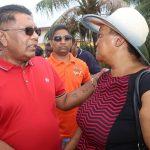As the National Assembly began considering the 2016 National Budget Estimates, the House late last evening approved $20.3B for the agricultural sector. This money will be used to create an economic environment in which farming and agro-processing operations can grow the economy and create employment.
As subject Minister Noel Holder stood to defend the sector’s allocation, he was questioned intensely by various opposition Members of Parliament, on the allocations, primarily that of the sugar industry which attracted $9B to assist in its modernisation and recovery.
Further, $598M is set aside for agriculture expansion in the Rupununi Savannahs, other hinterland areas and riverain communities. Agricultural diversification and product transformation are high on the agenda for areas such as Bina Hill, Ebini, Manari and Hosororo for the establishment of several training, research and extension facilities.
This will allow for the promotion of sustainable food production systems, thus maintaining the ecosystem. Additionally, it will concrete the ability to adapt to drought, flooding, and climate change..
In addition, the development of a milk pasteurisation plant is intended to revitalise the cattle industry. In Region Nine, there are 4,000 acres of state lands that are earmarked to build an agriculture trial station which is intended to facilitate sustainable harvesting of surface water for agriculture.
The land will be used for cattle rearing along with small ruminants; planting of vegetables and rice, in addition to aquaculture. The sub-sector will be invigorated with maximising the emphasis on animal health which will deal with emerging and known diseases.
The sector will also produce food and non- food commodities to satisfy the needs of Guyana and its international and regional partners. Additionally, government is committed to revitalising competition in the traditional agricultural sectors.
There will be increased focus in the fisheries sector, which will see the promotion of the sustainability of the marine fishery resources through continued efforts to attain Marine Stewardship Certification for the sea bob sub-sector. This will be complemented with the full implementation of the Vessel Monitoring System (VMS) on all trawlers and the enforcement of no-trawl zones and the harvest control rule.
Further, the Government will support innovation in sustainable aquaculture and inland fisheries sector with research and promotion of new marketable species.





